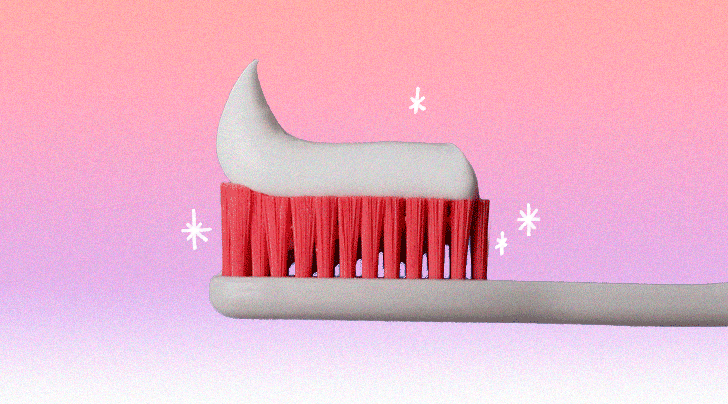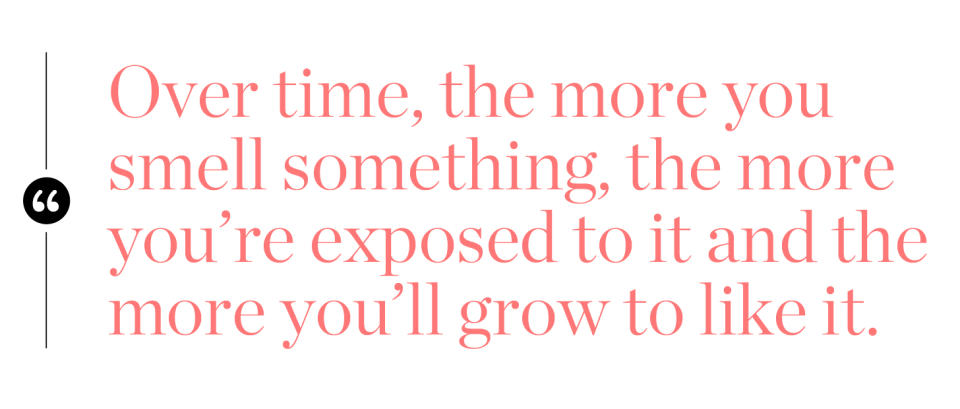Does Mint Actually Make Your Teeth Clean? Yes and No, Say the Experts

One morning, not too long ago, I was brushing my teeth. As the minty, foamy flavor filled my mouth, I mindlessly scanned the bathroom counter. There was the tube of toothpaste, the ice blue bottle of mouthwash and the little white container of floss. The unifying factor: They were all minty. Why not cinnamon? Or citrus? Or heck, why not chocolate? Is there some fundamental reason why clean = mint?
Sorta, it turns out. See, the dental-mint connection dates way back to the early 1900s, when a prominent ad exec named Claude C. Hopkins and an up-and-coming toothpaste company called Pepsodent joined forces. Their singular goal? To make toothpaste mainstream. That’s right—apparently just a little more than a century ago, brushing your teeth wasn’t yet a habit for the American people. Subsequently, tooth decay was at an all-time high (and make-out sessions at an all-time low, one can only imagine).
It’s hard to conceive why people wouldn’t brush their teeth more regularly—what with the bad breath and tooth decay and all—but after I did some digging into the history of oral care before the 20th century, their reluctance made a lot more sense.
Per the American Dental Association, “in ancient times a frayed end of a stick was generally employed to clean the teeth" (and subsequently shred your gums). As for toothpaste? Ha. Before our pals at Pepsodent made it a medicine-cabinet mainstay, “a dentist would provide patients with their own dentifrice mixtures in bottles and pots” that were “either a liquid or a more pasty concoction.” (If you can believe it, this was a step up from the earliest forms of toothpaste that date back to 5,000 B.C., which were concocted with naturally abrasive ingredients such as ox hooves, crushed bones and bark. Yum.)
This brings us back to Hopkins and Pepsodent and their goal of making toothpaste more palatable for the masses. As Charles Duhigg describes in his book The Power of Habit: Why We Do What We Do in Life and Business, they went about this in two ways: First, they got people’s attention through clever marketing (tale as old as time) and then they offered a sensory reward so that folks would keep buying the toothpaste.
Soon, nationwide billboards went up that pointed to a nefarious “dingy film” that clung to everyone’s teeth. The solution was simple, of course: Brush more and you could get a prettier, movie star smile. (It helped that actual movie stars like Clark Gable and Shirley Temple began endorsing the brand, attributing their megawatt grins to Pepsodent. #ad) Once people started brushing at home, they were immediately rewarded with an exciting feeling they had never experienced before: a minty-fresh mouth.
“Within five years of the initial campaign, something like 60 percent of American households had Pepsodent in their bathrooms,” reports Duhigg. Sure, people wanted Hollywood smiles, but what made them keep brushing their teeth was that addictively refreshing oral sensation they got whenever they did it.
As Robert Vogt, a senior flavorist at Colgate, explains, “There are various sensory receptors in your mouth that are activated by the coolness from the menthol in mint. That’s what provides the tingly experience you feel whenever you brush your teeth.”
So even though mint itself has nothing to do with dental hygiene, the feeling it produces in your mouth makes you think that it does.
“Peppermint has a dual paradox where it’s both cooling and warming, meaning when it touches the skin—or, in this case, your mouth—it feels cool, but then your body is stimulated to send blood to this area, which causes a warming sensation,” says Nicole Mancini, a senior perfumer at Givaudan.
And this tingly sensation is only half of the equation. The other half lies in the fresh, nostril-clearing scent of mint itself. As anyone who has ever taken a whiff of their mother’s perfume or their grandmother’s snickerdoodles knows, scent is deeply nostalgic.
“Your sense of smell is the one sense that bypasses the rational part of your brain and goes right to the cerebral cortex, which instantly takes you to a past moment. Over time, the more you smell something, the more you’re exposed to it and the more you’ll grow to like it. It becomes part of your olfactive lexicon—a part of your memory that is associated with certain parts of your life,” says Mancini.

This nostalgia-fueled American mint dream is still alive and well. In Othello, Washington, I met with the Schuttes, a third-generation family of farmers that supplies mint to companies such as Colgate-Palmolive (which makes Colgate and Tom’s of Maine). And while the vibe was very idyllic family farm (Sharon, the matriarch, regularly gifts vials of mint to neighbors to help with migraines, and she uses it around her own home to keep insects away), it’s clear the U.S. mint industry is booming, with more than 70 percent of the world’s supply of peppermint and spearmint produced here in the states.
But is this mix of industry and nostalgia specific to America? Or is it the case for teeth-brushers the world over?
As luck would have it, I was off to Korea to visit my family a few weeks later. After one particularly garlic-heavy meal, I went to my aunt’s bathroom to brush my teeth and found myself disappointed by her toothpaste, which was mildly minty at best. The flavor, though certainly not unpleasant, wasn’t what my mouth was used to. I wanted an arctic blast that left my gums numb and my breath downright chilly. What I got was a slightly sweet and muted mint flavor that tasted vaguely floral.
I tested the toothpaste in my uncle’s home, at a hotel (and then another hotel) and at my grandmother’s nursing home, and I peeped the oral care aisle at pretty much every grocery store I walked into during my stay. There were plenty of variants of mild mint in the motherland, but also bamboo salt, ginseng, charcoal and propolis (which is a resin-like byproduct of honeybees).
A quick call to Robert Vogt and it seems that the preference for mint so fresh it almost burns isspecific to North America. In other parts of the world, mint is a supporting ingredient, but not always the predominate flavor. For example, in China, many consumers prefer milder, tea-based flavors like jasmine or green tea, while in India, one of Colgate’s top-selling flavors is Swarna Vedshakti, which includes clove, neem, honey and tulsi.
“Depending on where you grew up and what you were exposed to, you will have a different association with a flavor or scent,” explains Mancini. While my cousin’s preference for propolis paste is puzzling to me, my beloved wintergreen makes her eyes water.
Luckily for all of us, flavor rarely has anything to do with actual dental hygiene; it’s simply there to make your toothpaste more palatable so you actually want to brush your teeth. And mint isn’t the active ingredient in toothpaste that whitens teeth or keeps cavities at bay; that workload falls to heavy hitters like fluoride and hydrogen peroxide.
But maybe that’s beside the point. As I learned, brushing your teeth is about more than just removing plaque and grime. It’s about memory, it’s about ritual and it’s about ascribing to societal norms—whether you’re in Korea or Kentucky.
Now let us all be thankful we no longer have to brush with the frayed end of a stick.
RELATED: Here’s How to DIY Your Own At-Home Steam Facial Using Mint

